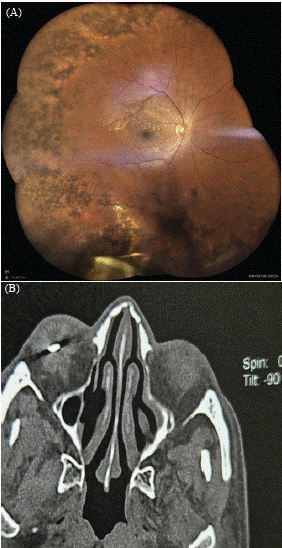
Clinical Image
Austin Ophthalmol. 2025; 9(1): 1070.
A Case of Retinal Siderosis Secondary to Neglected Ocular Trauma
Bouimtarhan A*, Bouabbadi C, Achegri Y, Azib S and Mouzari Y
Department of Ophthalmology, Morocco
*Corresponding author: BOUIMTARHAN AYOUB, Department of Ophthalmology, Morocco Email: ayoubenligne@gmail.com
Received: July 30, 2025 Accepted: August 15, 2025 Published: August 19, 2025
Clinical Image
We report the case of a 55-year-old patient, a mechanic by profession, with no notable medical or surgical history, who presented to the ophthalmology emergency department with a progressive and painless decrease in visual acuity in the right eye (OD) evolving over 3 months. The patient had suffered an ocular trauma 4 months prior, during a hammering maneuver, with retroprojection of a metal fragment into the OD.
The ophthalmological examination of the OD revealed a visual acuity of 1/10, a beginning cortico-nuclear cataract, and a pigmented vitreous Tyndall effect. The fundus oculi showed the presence of an intraocular foreign body (IOFB) in the inferior vitreous, measuring approximately 2 pupil diameters, with peripheral pigmentary migrations suggesting retinal siderosis. The examination of the fellow eye was normal.
The orbital and cerebral computed tomography scan confirmed the presence of a metallic density intraocular foreign body in the inferior vitreous of the OD. The electroretinogram (ERG) showed significantly decreased wave amplitudes with increased culmination times, consistent with severe retinal damage compatible with retinal siderosis (Figure 1).

Figure 1: (A) Fundus photograph showing the inferior intraocular foreign body
with peripheral retinal pigmentary changes. (B) Axial computed tomography
scan image demonstrating the intraocular foreign body with metallic density.
The diagnosis of retinal siderosis with severe retinal damage was retained. The visual prognosis was judged poor, and a combined surgical procedure (phacoemulsification + vitrectomy and IOFB extraction via the anterior route) was proposed to the patient. However, the patient refused any surgical intervention.